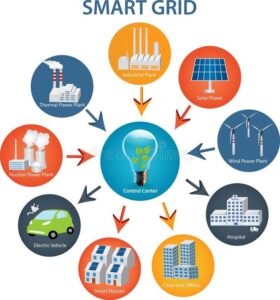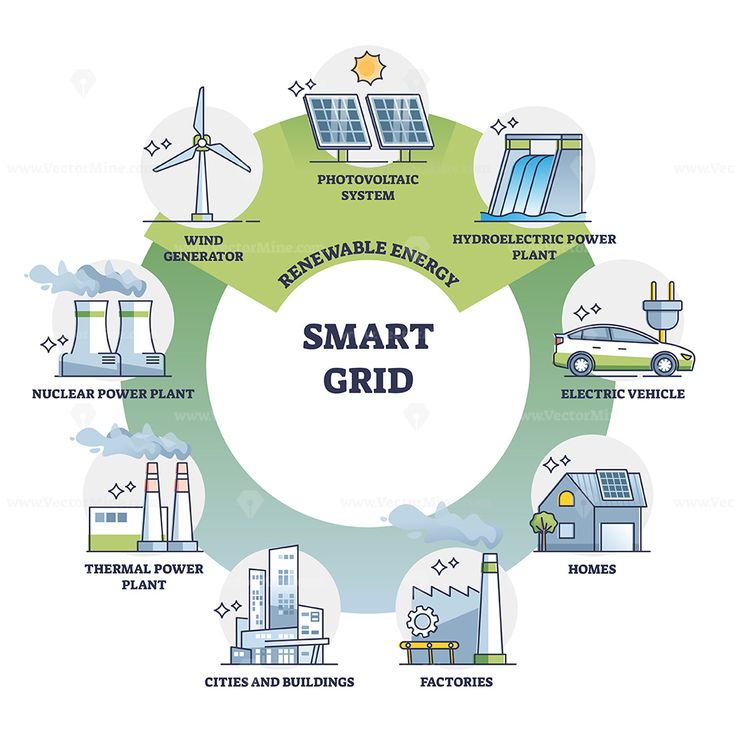
⚡ Smart Grids: The Revolutionary System for Energy Distribution
Today, I am presenting to you a unique and comprehensive piece on smart grids, being written for the first time in the world. This writing will tell you how smart grids are playing a crucial role in enabling efficient energy distribution, waste reduction, and clean urban lifestyles. If you like this material, please let us know, and if you need more details on any specific topic, you can contact us.
⚡ Smart Grids: The Revolutionary System for Energy Distribution
Smart grids have initiated a revolutionary transformation in the energy sector. These are state-of-the-art electrical grid systems equipped with digital communication technology, advanced sensors, and automated control systems. The fundamental feature of smart grids is their two-way communication capability, which creates real-time harmony between energy supply and demand. Unlike traditional grids, these systems not only deliver electricity but also receive data from consumers, keeping every aspect of energy flow under monitoring and control. Smart grids include Advanced Metering Infrastructure (AMI), which provides residential and commercial consumers with detailed information about their energy consumption. These meters not only record electricity consumption but can also analyze consumption patterns over time. Smart grids incorporate Automated Distribution Systems, which automate the electricity distribution process and can quickly detect and rectify any disruptions. These systems ensure power quality through power quality monitoring and control voltage fluctuations. Smart grids assist consumers in managing energy consumption through Demand Response Systems, reducing pressure on the grid during peak hours. These systems can integrate Distributed Energy Resources, including solar panels, wind turbines, and other renewable energy sources. All these features of smart grids collectively make the energy distribution system more efficient, reliable, and sustainable.
🌐 Global Implementation and Impacts of Smart Grids
The global implementation of smart grids has brought significant changes to the energy sector. The widespread adoption of smart grid technology in developed countries has led to remarkable improvements in energy sector efficiency. The comprehensive implementation of smart grids in European countries has not only improved the energy distribution process but has also facilitated the integration of renewable energy sources. Germany’s “Energiewende” project has enabled large-scale integration of solar and wind energy through smart grids. In the United States, large-scale investment in smart grid infrastructure under the Smart Grid Investment Grant Program has significantly improved grid resilience during storms and other natural disasters. China has established the world’s largest smart grid network, which is helping meet the country’s growing energy needs. In Japan, the implementation of smart grids was accelerated after the Fukushima incident, aiding energy security and stability. Under India’s “Power for All” initiative, the implementation of smart grid technology is improving electricity access in rural areas. In developing countries, the implementation of smart grids is not only reducing energy waste but also helping prevent illegal connections and theft. South Korea has conducted comprehensive testing and implementation of smart grid technology through the “Jeju Smart Grid Test Bed” project. In Australia, the implementation of smart grids has provided consumers with better awareness of energy consumption, promoting energy conservation. In Brazil, the implementation of smart grids has improved the management of hydroelectric power plants. These global impacts of smart grid implementation reflect how this technology is causing a revolutionary change in the energy sector.
💡 Efficient Energy Distribution and Waste Reduction
Smart grids are playing a crucial role in efficient energy distribution and waste reduction. In traditional power grids, the energy loss rate ranges from 8% to 15%, while smart grids can reduce this loss to less than 5%. Smart grids monitor every part of the grid through advanced sensors and monitoring systems, enabling immediate detection of any loss or wastage. These systems establish a better balance between energy demand and supply through real-time data analysis, reducing unnecessary energy production. Smart grids improve power quality through advanced voltage control methods, enhancing appliance performance and reducing energy waste. These systems improve power quality through power factor correction, reducing energy loss during transmission and distribution. Smart grids assist consumers in managing energy consumption through demand-side management, reducing pressure on the grid during peak hours and eliminating the need for generating units to operate at lower efficiency. Smart meters provide consumers with detailed information about their energy consumption, enabling them to better manage their usage. Smart grids make the energy production and distribution process more efficient by integrating distributed generation resources. These systems work in conjunction with energy storage systems, which store excess energy for use when needed. All these features of smart grids collectively provide a comprehensive solution for reducing energy waste and enabling efficient distribution.
🏙️ Promoting Clean Urban Lifestyles
Smart grids are playing a significant role in promoting clean urban lifestyles. Electricity demand in urban areas is continuously increasing, and smart grids are helping meet this demand while reducing environmental impacts. Smart grids help reduce carbon emissions in the urban transportation sector by integrating electric vehicle charging infrastructure. These systems enable large-scale integration of renewable sources like solar and wind energy, ensuring clean energy supply in cities. The integration of smart grids with smart buildings helps reduce energy consumption, improving energy efficiency in urban areas. Smart grids promote the establishment of microgrids, which are proving helpful in urban energy security and stability. These systems improve urban lighting management, reducing energy consumption and enhancing the urban environment. Through smart grids, air quality monitoring in urban areas can be conducted, helping control air pollution. These systems can also play an important role in water management, particularly by improving energy efficiency in water pumping and treatment processes. Smart grids can integrate urban waste management systems, making the process of generating energy from waste more efficient. All these capabilities of smart grids collectively play a crucial role in promoting clean and sustainable lifestyles in urban areas.
🔧 Technological Infrastructure and Advanced Systems
The technological infrastructure of smart grids consists of highly advanced and complex systems. This infrastructure primarily comprises four main components: sensing and measurement, communication, data management and analysis, and control and automation. The sensing and measurement sector includes smart meters, Phasor Measurement Units (PMUs), and intelligent electronic devices that collect data from various parts of the grid. The communication sector includes wired and wireless communication networks that transmit collected data to different locations. The data management and analysis sector includes data centers, cloud computing platforms, and data analytics tools that analyze collected data and provide useful information. The control and automation sector includes SCADA systems (Supervisory Control and Data Acquisition), Distribution Management Systems (DMS), and Outage Management Systems that automatically control various parts of the grid. Smart grids use artificial intelligence and machine learning algorithms that can predict grid issues in advance through data analysis. These systems can use blockchain technology to make energy transactions secure and transparent. Smart grids employ the latest cybersecurity systems to protect the grid from cyber attacks. These systems work in conjunction with Internet of Things (IoT) devices that connect various parts of the grid. This comprehensive technological infrastructure of smart grids makes them more efficient, secure, and reliable compared to traditional grids.
🌱 Environmental Benefits and Sustainability
The environmental benefits and sustainability role of smart grids cannot be overlooked. These systems help reduce carbon emissions by facilitating the integration of renewable energy sources. Through smart grids, variable sources like solar and wind energy can be integrated into the grid, reducing dependence on fossil fuels. These systems reduce total energy consumption by improving energy efficiency, which decreases the amount of fuel required for electricity generation. Smart grids help reduce carbon emissions in the urban transportation sector by enabling widespread use of electric vehicles. These systems improve the efficiency of power plants by optimising their operations, reducing emissions per unit of electricity generated. Smart grids help consumers manage energy consumption through demand response, eliminating the need to operate less efficient generating units during peak hours. These systems reduce waste in the energy production and distribution process by integrating distributed generation resources. The reduction in energy waste through smart grids helps conserve natural resources. These systems can provide data for environmental monitoring, helping improve environmental protection measures. All these environmental characteristics of smart grids make them an important means of achieving sustainable development goals.
🚀 Future Possibilities and Development Trends
The future possibilities and development trends of smart grids are extremely broad. In the coming years, further advancements in smart grid technology are expected, leading to increased efficiency in the energy sector. Increased use of artificial intelligence and machine learning will improve the predictive capabilities of smart grids, enabling early detection of grid issues. Widespread use of blockchain technology will increase transparency and security in energy transactions. The implementation of 5G technology will bring extraordinary improvements to smart grid communication capabilities, increasing data transmission speed and quality. The use of quantum computing could bring revolutionary changes to smart grid data analytics processes. The use of digital twin technology could enable continuous improvement in smart grid capabilities. The use of advanced cyber-security systems in smart grids will increase, protecting the grid from complex cyber attacks. Widespread implementation of micro-grids will increase the flexibility and stability of smart grids. Integration between smart grids and smart city infrastructure will increase, improving energy management in urban areas. These future development trends of smart grids reflect that this technology will continue to be a source of continuous progress and improvement in the energy sector.


